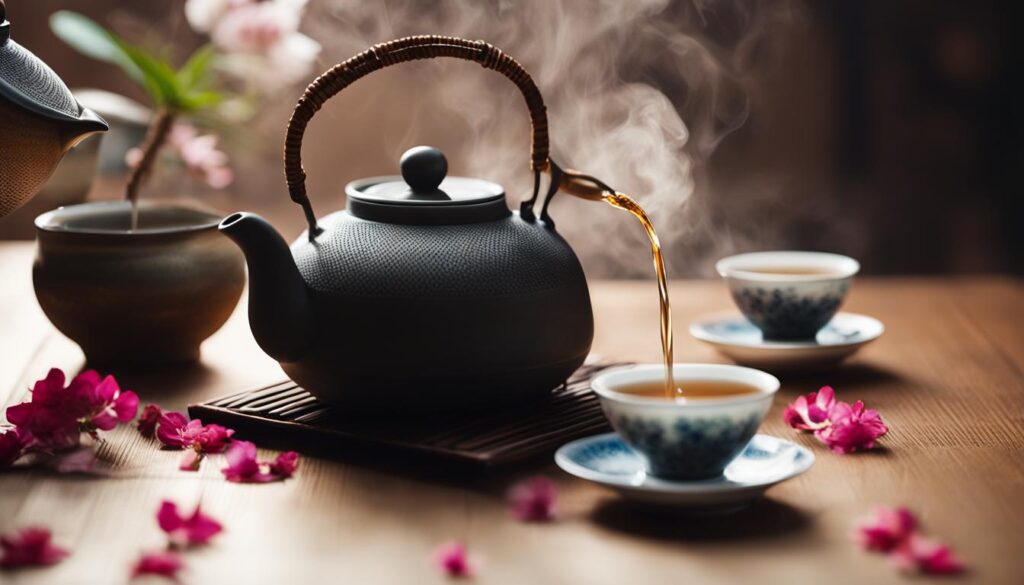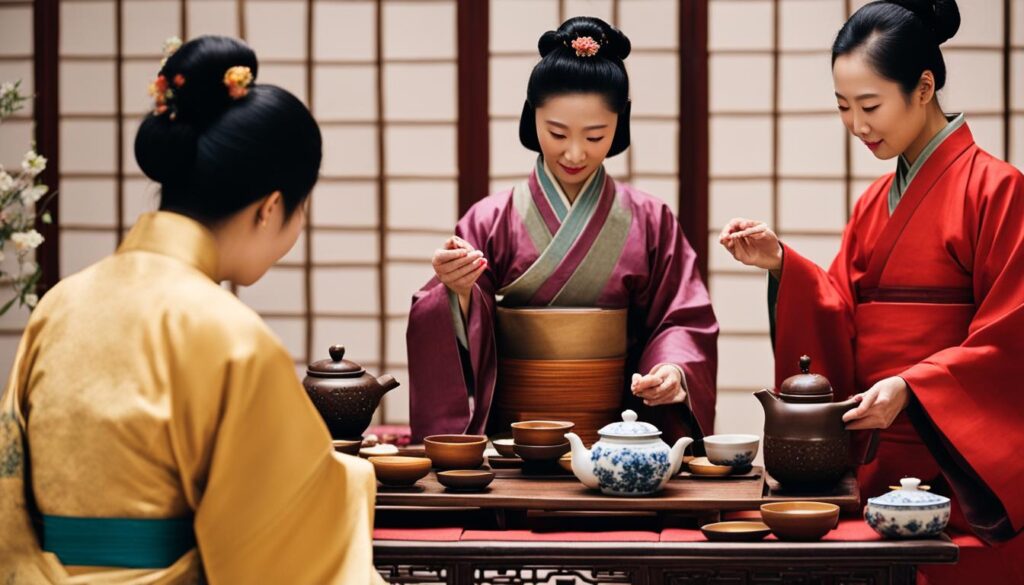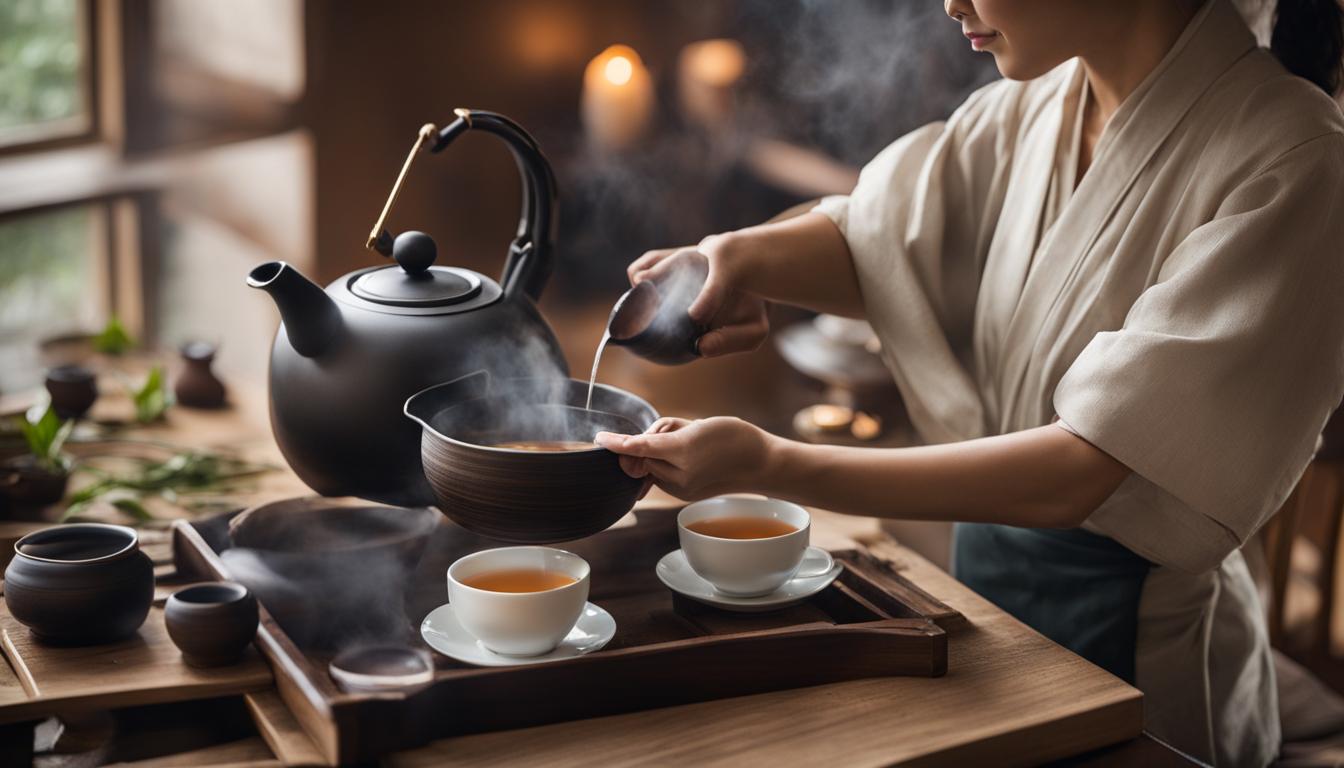Greetings tea enthusiasts! Today, we are embarking on an exciting journey into the world of traditional Chinese tea ceremonies. Whether you’re a newbie looking for a step-by-step tutorial or a seasoned tea connoisseur seeking to refine your pouring technique, we’ve got you covered.
Conducting a Chinese tea ceremony is a captivating way to immerse yourself in the rich cultural traditions of China. From the preparation to the brewing process and serving etiquette, every step is steeped in symbolism and respect. So, grab your favorite teapot and let’s dive in!
Key Takeaways:
- Conducting a Chinese tea ceremony is a beautiful way to honor tradition and create lasting memories.
- Proper preparation, including gathering the necessary tools and decorations, sets the stage for a successful ceremony.
- The ceremony follows a specific order of serving and pouring, with each cup offered with both hands as a sign of respect.
- Understanding the tea brewing process and serving etiquette is crucial for an authentic and meaningful ceremony.
- Tea attendants play a vital role in ensuring the smooth execution of the ceremony.
The Preparation
Before conducting a Chinese tea ceremony, it is important to gather the necessary tools and decorations. These include a stove or electric kettle for boiling water, a Chinese tea set (preferably red and cheerful with a double happiness character), bowls of dried dates, nuts, and candies, red decorations, pillows for respectful kneeling, chairs for the tea receivers, and optional Chinese wedding basket for gifts. The Chinese tea set can be purchased online or at Chinatowns. It is also recommended to prepare red double happiness decorations, flower arrangements, and bowls of whole in-shell walnuts, Chinese dates, whole peanuts, fresh longans, and wrapped Chinese candies. Clearing an area for the tea ceremony and arranging the chairs and table is also part of the preparation process.
Table: Chinese Tea Ceremony Preparation Checklist
| Items | Description |
|---|---|
| Stove or Electric Kettle | For boiling water |
| Chinese Tea Set | Preferably red with a double happiness character |
| Dried Dates, Nuts, and Candies | For serving with the tea |
| Red Decorations | To create a festive atmosphere |
| Pillows | For respectful kneeling |
| Chairs | For the tea receivers |
| Chinese Wedding Basket | Optional for displaying gifts |
| Red Double Happiness Decorations | To symbolize joy and luck |
| Flower Arrangements | To add beauty and elegance |
| Bowls of Walnuts, Dates, Peanuts, Longans, and Candies | To offer to the tea recipients |
The Ceremony Steps
Once the preparations are complete, it’s time to delve into the intricate steps of the Chinese tea ceremony. This deeply symbolic and ritualistic tradition follows a specific order of serving and pouring, embodying the values of respect, gratitude, and family unity.
Pouring Technique and Serving Order
With grace and intention, the tea is served to family members and esteemed elders. Traditionally, the groom’s family is served first, followed by the bride’s family. However, in modern and multicultural weddings, the order can be adjusted to suit the couple’s preferences. The serving order can also be based on seniority or any other meaningful arrangement.
As a symbol of respect and gratitude, the tea is individually offered by both the bride and groom. Each person receives a total of two cups of tea: one cup poured by the bride and another poured by the groom. If there is a larger group of family members, the tea can be served together by the couple, with the bride and groom taking turns pouring the tea into the cups.
The Ritual of Offering Tea
When offering the tea, it is essential to hold the tea cups with both hands as a sign of respect. The cups are presented to each family member, who then receives the tea and drinks it. After drinking the tea, they offer a gift to the couple as a token of their well wishes and blessings. This gift is often a red envelope, known as a “lai see,” containing money or gold jewelry.
“Serving tea in the Chinese tea ceremony involves proper etiquette and honorifics. The bride and groom should offer tea to their family members using respectful phrases such as ‘[Family member name], please have some tea.’”
The tea ceremony continues with the next group of family members until everyone has been served. Each recipient of the tea signifies their acceptance, respect, and support for the union of the couple. This beautiful tradition creates a sense of unity and harmony among family members and ensures that blessings and well wishes are bestowed upon the newly married couple.

| Step | Description |
|---|---|
| 1 | Pour tea for the groom’s family |
| 2 | Pour tea for the bride’s family |
| 3 | Serve tea together for larger groups |
| 4 | Offer tea cups with both hands |
| 5 | Recipient drinks the tea |
| 6 | Recipient offers a gift of blessings |
The Tea Brewing Process
In the Chinese tea ceremony, the process of brewing tea is crucial to achieving a flavorful and aromatic experience. The brewing method and water temperature vary depending on the type of tea being used. Here, we will explore the key steps and considerations for brewing tea during a traditional Chinese tea ceremony.
Each type of tea requires a specific water temperature for optimal brewing. Let’s take a look at the recommended water temperatures for different types of tea:
| Tea Type | Water Temperature |
|---|---|
| White Tea | 172-185°F |
| Green Tea | 172-185°F |
| Black Tea | 210°F |
| Oolong Tea | 185-212°F |
| Pu’er Tea | 212°F |
Once the appropriate water temperature is achieved, the tea leaves are steeped in a teapot for a specific duration. The steeping time varies depending on the type and quality of the tea. It is important to follow the recommended brewing time to extract the flavors and aromas properly.
During the tea ceremony, the tea is typically served in small cups, allowing the guests to savor each sip. The ceremony often involves multiple rounds of tea brewing, with the hosts carefully selecting and brewing different teas to offer a diverse tasting experience.
Key Points:
- Water temperature is crucial for brewing different types of tea.
- Each type of tea has a recommended steeping time.
- The tea is served in small cups during the ceremony.
- Multiple rounds of tea brewing are common in the Chinese tea ceremony.
Chinese Tea Serving Etiquette: A Sign of Respect and Tradition
Serving tea in a traditional Chinese tea ceremony is not just about pouring a beverage; it is a ritual steeped in symbolism and respect. Understanding the proper etiquette for serving tea is essential to honor the ceremony’s tradition and create a meaningful experience for all involved.
One important aspect of tea serving etiquette is the use of honorifics. When offering tea to family members, it is customary to address them with respect. For example, you might say, “Aunt Jane, please have some tea.” Using honorifics not only demonstrates your reverence for your elders but also reinforces the familial bonds and hierarchy within the ceremony.

“Tea is a symbol of respect and gratitude in Chinese culture. By offering tea with both hands and using honorifics, we show our appreciation for our family members and pay homage to our heritage.”
Another important aspect of tea serving etiquette is the way tea is offered. When presenting tea, always hold the cup with both hands as a sign of respect. This small gesture demonstrates your sincerity and acknowledges the significance of the moment. As they receive the cup, your family members will feel the warmth and care you’ve put into the ceremony.
Table: Chinese Tea Serving Etiquette
| Etiquette | Description |
|---|---|
| Use of honorifics | Address family members with respect and reverence. |
| Offering tea with both hands | Demonstrate sincerity and respect by holding the cup with both hands when presenting tea. |
| Proper tea pouring technique | Pour the tea smoothly and gracefully without spilling or splashing. |
| Offering tea in the correct order | Traditionally, serve tea to the groom’s family first, followed by the bride’s family, but the order can be adjusted to suit the couple’s preferences. |
The tea serving etiquette in a Chinese tea ceremony is a beautiful way to honor your family and heritage. By following these customs, you not only preserve tradition but create a memorable experience that embodies respect, gratitude, and unity.
The Role of Tea Attendants
In a traditional Chinese tea ceremony, tea attendants play a vital role in ensuring the smooth execution of the ceremony. Often bridesmaids, siblings, or cousins, tea attendants assist in various tasks such as preparing the tea, washing the cups, brewing the tea, and serving it to the family members. Their coordination and teamwork contribute to the overall elegance and success of the ceremony.
The responsibilities of tea attendants include carefully handling the tea and tea set to avoid any accidents or mishaps. This involves ensuring that the tea is brewed to perfection, maintaining the appropriate water temperature, and serving the tea with grace and respect. They also assist in maintaining the cleanliness and orderliness of the tea ceremony area.
Tea attendants should be well-versed in the traditional tea ceremony protocols and etiquette. They should understand the significance of each step in the ceremony and be able to perform their roles with precision and efficiency. Their attentive presence adds to the ambiance of the tea ceremony, creating a sense of reverence and appreciation for the ritual.
Table: Responsibilities of Tea Attendants
| Responsibilities | Description |
|---|---|
| Preparing the tea | Gathering the necessary tea leaves, boiling water, and ensuring the tea is brewed to perfection. |
| Washing the cups | Cleaning the cups thoroughly to maintain hygiene and presentation. |
| Brewing the tea | Ensuring the appropriate water temperature and steeping time for each type of tea. |
| Serving the tea | Offering the tea to family members with respect and grace, following the serving order. |
| Maintaining cleanliness | Keeping the tea ceremony area tidy and organized throughout the ceremony. |
The tea attendants’ role extends beyond their physical tasks; they contribute to the overall atmosphere and harmony of the ceremony. By cooperating with one another and the couple, tea attendants help create a memorable experience for both the families and the newlyweds.
Conclusion
As we conclude our journey through the traditional Chinese tea ceremony, we can’t help but admire the rich tradition and significance it holds in Chinese culture, particularly in weddings. This time-honored ritual symbolizes the coming together of two families and serves as a beautiful expression of respect and gratitude.
By meticulously preparing for the ceremony, gathering the necessary tools and decorations, and setting the stage for an unforgettable experience, you can infuse tradition into your gatherings and create lasting memories.
The tea ceremony’s true beauty lies in the unity it fosters and the opportunity it provides for family members to express their heartfelt wishes to the happy couple. Through the proper adherence to the serving and pouring order, the use of respectful honorifics, and the observance of tea etiquette, you can conduct this ceremony with elegance and grace.
So, whether you’re planning a wedding or simply eager to delve into the art of Chinese culture, the traditional Chinese tea ceremony is a meaningful and unforgettable way to honor tradition and create a sense of togetherness.
FAQ
What is a traditional Chinese tea ceremony?
A traditional Chinese tea ceremony is an important part of Chinese culture, especially in weddings. It involves serving tea to family members and esteemed elders as a sign of respect and gratitude.
Where does the tea ceremony take place?
The tea ceremony usually takes place at the homes of the bride and groom, but can also be conducted in one location for convenience.
What tools and decorations are needed for a Chinese tea ceremony?
Some of the necessary tools and decorations include a Chinese tea set, bowls of dried dates and candies, red decorations, pillows, chairs, and optional Chinese wedding basket for gifts.
Who should be served tea first in the ceremony?
Traditionally, the tea is served to the groom’s family first, followed by the bride’s family. However, the order can be adjusted to suit the couple’s preferences.
How should the tea be offered?
The tea should always be offered with both hands as a sign of respect. Each person should receive a total of 2 cups of tea.
What is the significance of the tea brewing process?
The tea brewing process is important for ensuring a flavorful and aromatic tea. The temperature and steeping duration vary depending on the type of tea.
What is the proper etiquette for serving tea in the ceremony?
The bride and groom should offer tea to their family members using respectful phrases and offer the tea with both hands. After receiving the tea, family members should offer their gifts and speak words of congratulations and well wishes.
What role do tea attendants play in the ceremony?
Tea attendants help in preparing the tea, washing the cups, brewing the tea, and serving it to the family members. They play a significant role in ensuring a smooth and successful tea ceremony.
What is the significance of the Chinese tea ceremony?
The Chinese tea ceremony symbolizes the unity of two families and offers an opportunity for relatives to express their best wishes and congratulations to the couple. It is a beautiful way to infuse tradition into gatherings and create lasting memories.





